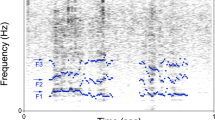Abstract
Vocal recordings of one semi-free-ranging group and one captive group of Tonkean macaques (Macaca tonkeana) were used to establish the vocal repertoire of the species. Only the alpha male of the groups uttered a very distinctive loud call. Localization variants of coo calls were found. Alarm calls given by this species were acoustically similar to those by Japanese, rhesus, and long-tailed macaques (M. fuscata, M. mulatta, andM. fascicularis). Adult females uttered a specific variant of vocalizations during sexual morphological changes. The repertoire of agonistic vocalizations was more variable than that of any other macaque species investigated. These characteristics were discussed with reference to previous studies on vocalizations of macaque species.
Similar content being viewed by others
References
Caldecott, J. O., 1986.An Ecological and Behavioural Study of the Pig-tailed Macaque. Contribution to Primatology, Vol. 21, Karger, Basel.
Deag, J. M., 1974.A Study of the Social Behaviour and Ecology of the Wild Barbary Macaque, Macaca sylvanusLinnaeus. Unpublished Ph.D. Thesis, Univ. Bristol, Bristol.
Deputte, F. L. &M. Goustard, 1980. Copulatory vocalizations of female macaques (Macaca fascicularis): variability factor analysis.Primates, 21: 83–99.
Fooden, J., 1975.Taxonomy and Evolution of Liontail and Pigtail Macaques (Primates: Cercopithecidae). Fieldiana Zoology, Vol. 67, Field Museum of Natural History, Chicago.
————, 1980. Classification and distribution of living macaques (Macaca Lacepede, 1799). In:The Macaques: Studies in Ecology, Behavior and Evolution,D. G. Lindburg (ed.), Van Nostrand Reinhold, New York, pp. 1–9.
Green, S., 1975. Variation of vocal pattern with reference to social situations in the Japanses monkey: a field study. In:Primate Behavior, Vol. 4,L. A. Rosenblum (ed.), Academic Press, New York. pp. 1–102.
Grimm, R. J., 1967. Catalogue of sounds of the pigtailed macaque (Macaca nemestrina).J. Zool., 152: 361–373.
Herrenschmidt, N., 1977. Semi-free breeding of tropical Celebes macaques (Macaca tonkeana) in a continental European climate.J. Med. Primatol., 6: 58–65.
Hohmann, G., 1989. Vocal communication of wild bonnet macaques (Macaca radiata).Primates, 30: 325–345.
———— &M. O. Herzog, 1985. Vocal communication in lion-tailed macaques (Macaca silenus).Folia Primatol., 45: 148–178.
Itani, J., 1963. Vocal communication in the wild Japanese monkey.Primates, 4: 11–66.
Lindburg, D. G., 1971. The rhesus monkey in North India: an ecological and behavioural study. In:Primate Behavior, Vol. 2,L. A. Rosenblum (ed.), Academic Press, New York, pp. 65–134.
————, 1980.The Macaques: Studies in Ecology, Behavior and Evolution. van Nostrand Reinhold, New York.
————, 1990. Proceptive calling by female lion-tailed macaques.Zoo Biol., 9: 437–466.
Marshall, J. T. &E. R. Marshall, 1976. Gibbons and their territorial songs.Science, 163: 93–95.
Masataka, N., 1983. Psycholinguistic analyses of alarm calls of Japanese monkeys (Macaca fuscata fuscata).Amer. J. Primatol., 5: 111–125.
———— &D. Symmes, 1986. Effects of separation distance on isolation call structure in squirrel monkeys (Saimiri sciureus).Amer. J. Primatol., 10: 271–278.
Nadler, R. D., 1992. Sexual behavior and the concept of estrus in the great apes. In:Topics in Primatology, Vol. 2,N. Itoigawa,Y. Sugiyama,G. P. Sackett, &R. K. R. Thompson (eds.), Univ. Tokyo Press, Tokyo, pp. 191–208.
Oates, J. F. &T. F. Trocco, 1983. Taxonomy and phylogeny of black-and-white colobus monkeys: inferences from an analysis of loud call variation.Folia Primatol., 40: 83–113.
Oda, R. &N. Masataka, 1992. Functional significance of female Japanese macaque copulatory calls.Folia Primatol., 58: 146–149.
Palomboit, R. A., 1992. A preliminary study of vocal communication in wild long-tailed macaques (Macaca fascicularis). I. Vocal repertoire and call emission.Int. J. Primatol., 13: 143–187.
Rowelll, T. A., 1962. Agonistic noise of the rhesus monkey (Macaca mulatta).Symp. Zool. Soc. Lond., 8: 91–96.
———— &R. A. Hinde, 1962. Vocal communication by rhesus monkey (Macaca mulatta).Proc. Zool. Soc. Lond., 128: 279–294.
Schaik, C. P. van &M. A. van Noordwijk, 1985. Evolutionary effects of the absence of felids on the social organization of the macaques of the island of Simeulue (Macaca fascicularis fusca,Miller 1903).Folia Primatol., 44: 138–147.
Smith, W. J., 1977.The Behavior of Communicating. Harvard Univ. Press, Cambridge, Massachusetts.
Struhsaker, T. T., 1970. Phylogenetic implications of some vocalizations ofCercopithecus monkeys. In:Old World Monkeys,M. Napier &B. Napier (eds.), Academic Press, New York, pp. 365–444.
Sugiyama, Y., 1968. The ecology of the liontailed macaque (Macaca silenus Linnaeus): a pilot study.J. Bombay Nat. Hist. Soc., 65: 283–293.
Thierry, B., 1984. Clasping behaviour inMacaca tonkeana.Behaviour, 89: 1–28.
————, 1985. Patterns of agonistic interactions in three species of macaque (Macaca mulatta, M. fascicularis, M. tonkeana).Agg. Behav., 11: 223–233.
————, 1990. Feedback loop between kinship and dominance: the macaque model.J. Theor. Biol., 145: 511–521.
————,C. Demaria, S. Preuschoft, &C. Desportes, 1989. Structural convergence between silent bared-teeth display and relaxed open-mouth display in the Tonkean macaque (Macaca tonkeana).Folia Primatol., 52: 178–184.
Thurlow, W. R., 1971. Audition. In:Experimental Psychology.J. W. King &L. A. Riggs (eds.), Holt Rinehart & Winston, New York, pp. 223–259.
Watanabe, K., 1979. Some observations of the Mentawai pigtail macaques,Macaca nemestrina pagensis, on Siberut Island, West Sumatra, Indonesia. In:A comparative Sociological Studies on Coloboid Monkeys in Tropical Asia, Report of Overseas Scientific Survey in 1976 – 1978,S. Kawamura (ed.), Primate Research Institute, Kyoto University, Inuyama, pp. 86–92.
Whiten, A. J. &J. E. J. Whiten, 1982. Preliminary observations of the Mentawai macaques on Siberut Island, Indonesia.Int. J. Primatol., 3: 445–459.
Wilson, W. L. &C. C. Wilson, 1977. Species-specific vocalizations and the determination of phylogenetic affinities of thePresbytis ayugula-melalophos group in Sumatora. In:Contemporary Primatology,S. Kondo,A. Ehara, &M. Kawai (eds.), Karger, Basel, pp. 459–463.
Author information
Authors and Affiliations
About this article
Cite this article
Masataka, N., Thierry, B. Vocal communication of tonkean macaques in confined environments. Primates 34, 169–180 (1993). https://doi.org/10.1007/BF02381388
Received:
Accepted:
Issue Date:
DOI: https://doi.org/10.1007/BF02381388




